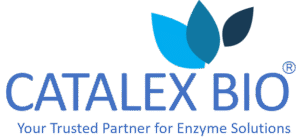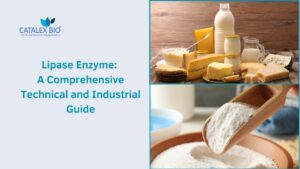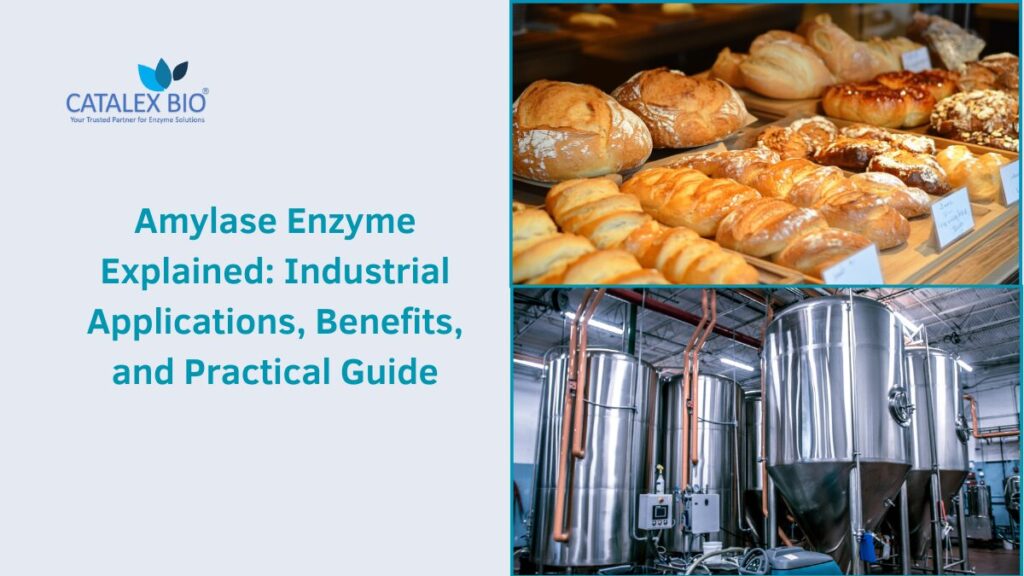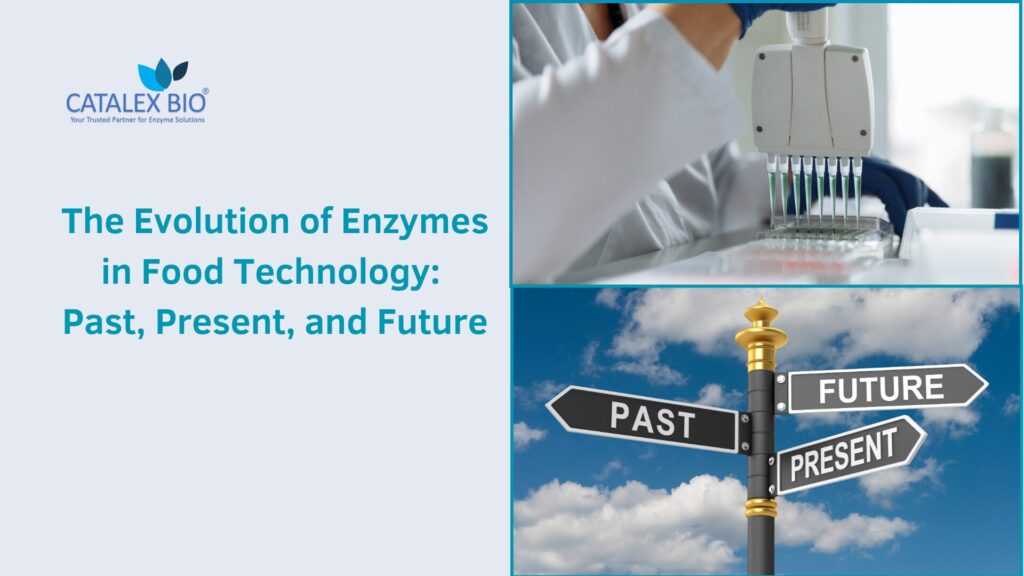1. Introduction
Enzymes have transformed industrial biotechnology, replacing harsh chemical processes with eco-friendly, highly efficient biocatalysts. Among these, Lipase (EC 3.1.1.3) holds a unique place due to its ability to break down fats and oils — a property that makes it vital across industries such as food, dairy, detergents, pharmaceuticals, biodiesel, leather, pulp & paper, animal feed, and waste management.
Lipases are hydrolytic enzymes that catalyze the cleavage of ester bonds in triglycerides, converting them into glycerol and free fatty acids. Beyond hydrolysis, lipases also catalyze esterification, interesterification, and transesterification reactions, making them highly versatile for industrial biocatalysis. Their specificity, efficiency, and ability to work under mild conditions have positioned them as critical tools for sustainable, green processes.
Today, microbial lipases dominate industrial applications due to advantages such as high stability, cost-effective large-scale production, and tunable properties through genetic and protein engineering. Depending on the application, industries select between fungal lipases (preferred for food, flavor, and mild processes) and bacterial lipases (favored for alkaline, thermostable, and heavy-duty processes like detergents and biodiesel).
At Catalex Bio, we provide high-quality lipase solutions tailored for different industries, backed by deep technical expertise, reliable sourcing, and regulatory compliance. With our enzyme portfolio, customers gain efficiency, consistency, and sustainability in their processes.
This article offers a comprehensive technical and practical guide to Lipase, covering:
- History and discovery of lipase
- Structure and mechanism of action
- Sources of lipase (fungal, bacterial, animal, plant)
- Industrial applications
- Comparison between fungal and bacterial lipases
- Units of activity and assay methods
- User guidance for industries
- Future outlook and innovations
2. History and Discovery of Lipase
The history of lipase enzymes reflects both scientific curiosity and industrial innovation. Their ability to break down fats and oils has been observed in nature for centuries, but their systematic study and commercial use are relatively recent compared to enzymes like amylase.
Early Observations (18th–19th Century)
- 1783 – First insights into fat digestion: Early physiologists recognized that pancreatic secretions were responsible for breaking down dietary fats, though the specific catalytic component was not yet identified.
- 19th Century – Pancreatic lipase discovery: Scientists confirmed that a heat-sensitive protein fraction in pancreatic juice could hydrolyze fats into fatty acids and glycerol. This was the first biochemical evidence of lipase activity in animals.
Early 20th Century – Expanding understanding
- Researchers isolated lipolytic activity from various biological sources, including plants (oil seeds) and microorganisms.
- By the 1930s–1940s, fungal lipases (from Rhizopus, Aspergillus, and Candida) were being studied for their ability to hydrolyze oils in fermentation and food processing.
Mid 20th Century – Industrial adoption
- Food and dairy industries: Lipases began to be used to enhance cheese ripening, improve flavors in dairy, and modify fats for margarine production.
- Detergents: By the 1960s–1970s, alkaline-stable bacterial lipases were introduced into detergents to break down grease stains, making them a household name.
- Oil and fat processing: Lipases were explored for enzymatic interesterification, offering a clean alternative to chemical catalysts for modifying edible fats.
Late 20th Century – Microbial fermentation era
- Large-scale microbial fermentation made lipases commercially viable. Fungi such as Candida rugosa, Rhizomucor miehei, and Aspergillus niger, along with bacteria such as Bacillus and Pseudomonas species, became industrial workhorses.
- Immobilized lipases were developed to allow continuous processing in biodiesel and food oil modification, reducing costs and improving reusability.
Present day – Engineered lipases
- Advances in protein engineering, directed evolution, and metagenomics have led to tailor-made lipases with improved thermostability, activity in non-aqueous solvents, and substrate specificity.
- Lipases are now central to green chemistry, supporting sustainable production of biofuels, pharmaceuticals, biodegradable plastics, and specialty chemicals.
3. Structure and Mechanism of Lipase Action
Lipases belong to the serine hydrolase family of enzymes. Their primary function is to catalyze the hydrolysis of ester bonds in triglycerides, producing glycerol and free fatty acids. However, unlike many hydrolases, lipases also catalyze reverse reactions such as esterification, transesterification, and interesterification, which greatly expands their industrial utility.
3.1 Types of Lipase (Based on Function and Specificity)2 Catalytic Mechanism of Lipase Action
The catalytic site of most lipases contains the classical catalytic triad:
- Serine (Ser) – Nucleophile that attacks the ester bond.
- Histidine (His) – Acts as a base, activating the serine residue.
- Aspartic acid (Asp) / Glutamic acid (Glu) – Stabilizes the histidine and maintains charge balance.
Step-by-step mechanism:
- Substrate binding: Lipase binds to the triglyceride substrate at the lipid-water interface.
- Nucleophilic attack: The serine hydroxyl group attacks the carbonyl carbon of the ester bond.
- Tetrahedral intermediate formation: A transient intermediate is stabilized by an “oxyanion hole” in the enzyme structure.
- Acyl-enzyme complex: The fatty acid is released, leaving an acyl-enzyme intermediate.
- Deacylation: A water molecule (hydrolysis) or an alcohol (transesterification) reacts, releasing the remaining product and regenerating the enzyme.
This interfacial activation mechanism is a hallmark of lipases — they become catalytically active when adsorbed onto oil–water interfaces, a property not seen in most hydrolases.
3.3 Factors Affecting Lipase Activity
- pH:
- Fungal lipases → typically active at pH 4.5–6.5 (suited for food and dairy).
- Bacterial lipases → often stable in neutral to alkaline pH (7–10) (ideal for detergents and biodiesel).
- Temperature:
- Fungal lipases → Optimal activity at 30–55 °C.
- Thermostable bacterial lipases → Active up to 60–90 °C, some even above 100 °C.
- Substrate Specificity:
Some lipases are highly specific (sn-1, sn-3 positions), while others act randomly. This specificity is exploited in structured lipid synthesis and nutraceuticals. - Metal Ions & Additives:
Calcium often stabilizes lipase structure. Surfactants can enhance activity in detergents. Heavy metals, however, generally act as inhibitors. - Solvent Tolerance:
Many engineered lipases remain active in non-aqueous solvents, enabling applications in esterification and biodiesel production.
The structural adaptability and broad catalytic range of lipases make them far more versatile than simple hydrolytic enzymes, explaining their widespread industrial adoption.
4. Sources of Lipase
Lipases occur widely in nature — in microorganisms, plants, and animals — reflecting their fundamental role in fat metabolism. However, industrial production today relies primarily on microbial fermentation, due to scalability, cost-effectiveness, and process adaptability.
4.1 Fungal Sources
Fungal lipases are widely used in food, dairy, and flavor industries because they function well at mild pH and moderate temperatures.
- Aspergillus niger – Produces acid-stable lipases, used in food processing and juice clarification.
- Rhizomucor miehei – Source of immobilized lipases for fat modification and biodiesel.
- Candida rugosa – Versatile lipase, applied in pharmaceuticals, cosmetics, and food flavor development.
- Geotrichum candidum – Used in cheese ripening for aroma and flavor development.
Key advantage: Fungal lipases are active under acidic to neutral conditions, making them suitable for food-grade applications.
4.2 Bacterial Sources
Bacterial lipases dominate industrial and detergent applications due to their high stability in alkaline pH and at elevated temperatures.
- Bacillus subtilis – Produces thermostable, alkaline lipases used in detergents and biodiesel.
- Bacillus stearothermophilus – Known for heat-resistant lipases.
- Pseudomonas fluorescens and Pseudomonas aeruginosa – Highly active lipases with broad substrate specificity, applied in oil modification and waste treatment.
- Burkholderia cepacia – Produces lipases with transesterification activity, used in pharmaceuticals and fine chemicals.
Key advantage: Bacterial lipases show high activity in alkaline and solvent-rich environments, ideal for detergents and biodiesel industries.
4.3 Plant Sources
Lipases are naturally present in oilseeds and germinating plants, where they mobilize stored lipids.
- Castor bean (Ricinus communis) lipase – Early source of plant lipase, though limited for industrial use.
- Germinating grains and oilseeds – Contain lipolytic activity important in seed metabolism.
Limitation: Plant lipases are not widely used industrially due to low yields and extraction costs compared to microbial fermentation.
4.4 Animal Sources
Pancreatic lipase – Found in mammals (including humans), plays a crucial role in fat digestion.
- Gastric lipase – Active at low pH in the stomach.
Use: Animal lipases are mainly restricted to diagnostics and medical research; not commonly used industrially because of cost, variability, and ethical constraints.
4.5 Modern Biotechnology Sources
- Recombinant DNA Technology: Lipases expressed in hosts like E. coli or Pichia pastoris provide high yields and engineered properties.
- Immobilized Lipases: Immobilization on resins or silica allows reuse in continuous processes, widely used in biodiesel and specialty lipid synthesis.
- Protein Engineering: Directed evolution has created lipases with improved solvent tolerance, higher thermostability, and enhanced substrate specificity.
Overall, while lipases are naturally widespread, microbial fermentation (fungal and bacterial) remains the backbone of industrial lipase production due to cost efficiency, consistency, and ease of scaling.
5. Industrial Applications of Lipase
Lipase is among the top industrial enzymes sold globally, with applications spanning from food and dairy to biodiesel and detergents. Its ability to perform hydrolysis, esterification, and transesterification under mild conditions makes it indispensable across industries.
5.1 Food and Dairy Industry
Lipase plays a central role in the flavor, texture, and functionality of foods.
A. Cheese Ripening and Flavor Development
- Lipase hydrolyzes milk fat to release free fatty acids, which contribute to the distinct flavor profile of cheeses such as Parmesan, blue cheese, and Romano.
- Fungal lipases (Rhizopus, Mucor miehei, Aspergillus) are most commonly used for controlled flavor release.
- Different lipases create specific flavor notes — short-chain fatty acids give pungent notes, while medium/long-chain contribute to creamy or buttery flavors.
B. Bakery Applications
- Lipase modifies flour lipids, improving dough stability, volume, and crumb softness.
- Enhances gas retention during fermentation, resulting in better loaf volume.
- Reduces staling, extending bread shelf life.
- Fungal lipases are preferred due to food safety and mild action at dough pH (~6.0).
C. Oil and Fat Modification
- Lipase is used in interesterification to rearrange fatty acids in triglycerides, altering melting properties of oils.
- Produces margarine, cocoa butter equivalents (CBE), low-calorie structured lipids, and nutraceutical fats.
- Immobilized lipases ensure reusability in large-scale oil modification.
D. Dairy Fat Modification
- Used to hydrolyze milk fat for infant formula production (mimicking human milk fat structure).
- Applied in low-fat dairy products for texture improvement.
Benefits: Clean-label processing, mild reaction conditions, selective modification.
5.2 Detergent Industry
Lipase revolutionized modern detergents by enabling enzymatic fat and grease removal.
- Bacterial lipases (Bacillus, Pseudomonas) are favored due to their alkaline stability and thermostability.
- Lipase breaks down oil-based stains such as butter, vegetable oils, meat fats, sauces, and sebum.
- Combined with proteases and amylases in detergent formulations for a multi-enzyme cleaning system.
Benefits:
- Effective cleaning at lower wash temperatures → saves energy.
- Works under alkaline pH (9–11) conditions of modern detergents.
- Eco-friendly replacement for harsh chemical surfactants.
5.3 Animal Feed Industry
Lipase supplementation improves nutrient utilization and growth performance in livestock and aquaculture.
- Breaks down dietary fats into absorbable fatty acids and glycerol.
- Enhances feed conversion ratio (FCR) in poultry, swine, and fish.
- Acid-stable lipases can function in the stomach (low pH), aiding fat digestion.
- Bacterial lipases withstand pelleting temperatures during feed manufacturing.
Benefits:
- Better weight gain and energy release from diets.
- Allows inclusion of low-cost or low-fat diets without compromising performance.
- Reduces fecal fat excretion, improving environmental sustainability.
5.4 Leather Industry
In leather processing, lipase is used for degreasing hides and skins.
- Removes natural fats and oils during the soaking and liming stages.
- Replaces harsh chemical solvents traditionally used.
- Fungal lipases provide gentle, eco-friendly degreasing, preserving hide quality.
- Bacterial lipases may be used in alkaline degreasing for faster processing.
Benefits:
- Cleaner hides, better grain structure.
- Lower wastewater load and reduced environmental pollution.
5.5 Pharmaceutical Industry
Lipase is a key biocatalyst in the synthesis of optically pure drug intermediates.
- Performs enantioselective hydrolysis and esterification, critical for chiral drug synthesis.
- Used in the preparation of NSAIDs, beta-blockers, antivirals, and prodrugs.
- Immobilized fungal lipases (Candida rugosa, Rhizomucor miehei) are widely used due to high enantioselectivity.
Benefits:
- Produces optically pure products without harsh chemicals.
- Aligns with green chemistry principles.
5.6 Biodiesel Production
Lipase catalyzes transesterification of triglycerides (vegetable oils or animal fats) into fatty acid methyl esters (FAMEs) and glycerol.
- An eco-friendly alternative to chemical catalysts (NaOH, KOH).
- Bacterial and immobilized lipases (Burkholderia, Pseudomonas) are solvent-tolerant and robust.
- Fungal lipases (Candida antarctica, Rhizopus) are used in solvent-free biodiesel processes.
Benefits:
- No soap formation, unlike chemical processes.
- Easier glycerol recovery.
- Reusable enzymes when immobilized → reduces cost.
5.7 Pulp and Paper Industry
Lipase is applied in pitch control during paper manufacturing.
- Pitch = triglycerides, steryl esters, and other lipophilic substances that deposit on machinery.
- Lipase hydrolyzes these compounds, preventing deposition.
- Improves paper quality, surface smoothness, and printability.
Benefits:
- Lower downtime and maintenance costs.
- Reduces use of chemical dispersants.
5.8 Wastewater and Environmental Management
Lipase plays a critical role in bioremediation of oily wastewater.
- Treats effluents from food, dairy, slaughterhouses, and oil-processing plants.
- Breaks down fats, oils, and grease (FOG), reducing COD and BOD.
- Prevents clogging in sewage systems.
- Often used in combination with proteases and amylases in multi-enzyme formulations.
Benefits:
- Reduces environmental pollution.
- Supports sustainable waste management.
5.9 Cosmetic and Personal Care Industry
Lipase is emerging in cosmetics and specialty chemicals:
- Used to produce structured lipids, bioactive esters, and surfactants.
- Helps synthesize emollients and aroma compounds.
- Contributes to clean-label and green chemistry formulations.
Benefits:
- Non-toxic, biodegradable, mild processing.
- Expands product innovation opportunities in personal care.
6. Fungal vs. Bacterial Lipase: Detailed Comparison
Both fungal and bacterial lipases are widely used in industry, but their properties, stability, and application suitability differ significantly. Understanding these differences helps industries choose the right enzyme for their processes.
| Parameter | Fungal Lipase | Bacterial Lipase |
|---|---|---|
| Source | Aspergillus niger, Candida rugosa, Mucor miehei, Rhizopus oryzae | Bacillus subtilis, Pseudomonas fluorescens, Burkholderia cepacia |
| Optimal pH | 4.5 – 7.0 (acidic to neutral) | 7.0 – 10.5 (neutral to alkaline) |
| Temperature Range | 25 – 45 °C | 35 – 60 °C (some thermophilic strains up to 70 °C) |
| Substrate Preference | Medium and long-chain triglycerides; flavor release | Broad range, including oils, fats, and greases |
| Applications | Cheese ripening, bakery, dairy, flavor synthesis, edible oil modification | Detergents, biodiesel, leather, wastewater treatment, pulp & paper |
| Advantages | – High specificity and enantioselectivity – Generally extracellular – Recognized as food-safe | – Robust, thermostable, alkaline-stable – Solvent-tolerant – Fast microbial growth and production |
| Limitations | – Sensitive to high pH and temperature – Lower solvent tolerance | – Some are intracellular or membrane-bound – Lower substrate selectivity compared to fungal lipases |
Rule of Thumb for Industry Users
- Use fungal lipases when working with food, dairy, flavors, and specialty oils where specificity and mild conditions are required.
- Use bacterial lipases for heavy-duty applications like detergents, biodiesel, pulp & paper, and wastewater treatment, where robustness and alkaline stability are critical.
7. Units of Lipase Activity Measurement
Like other industrial enzymes, lipase activity is expressed in terms of how much substrate the enzyme can hydrolyze (or product it can release) under defined conditions of pH, temperature, and substrate type. Different industries and suppliers may use different activity units.
7.1 Common Units of Lipase Activity
- IU (International Unit):
- 1 IU = the amount of enzyme that hydrolyzes 1 µmol of fatty acid ester per minute under standard conditions.
- Most widely used in research and pharmaceutical industries.
- LU (Lipase Unit):
- Defined as the amount of enzyme that releases 1 µmol of fatty acid per minute from triglycerides at specific assay conditions.
- Commonly used in food and detergent industries.
- FIP Unit (Federation Internationale Pharmaceutique):
- Standardized for pharmaceutical-grade lipases (e.g., pancreatic lipase).
- Defined by titration of fatty acids released from olive oil emulsion.
- Used in medical and nutraceutical applications.
- PLU (Propyl Laurate Units):
- Measures hydrolysis of propyl laurate substrate.
- Applied in specialty enzyme products (mainly pharma and fine chemicals).
- GPLU (Gum Arabic–Olive Oil Lipase Units):
- Defined by activity on emulsified olive oil stabilized with gum arabic.
- Traditional but still referenced in some dairy/lab assays.
- Vendor-Specific Units:
- Some enzyme manufacturers define proprietary activity units depending on assay protocols, often not directly interchangeable with IU or LU.
7.2 Which Units Are Most Common in Industry?
- Food & Dairy: LU, FIP units.
- Detergents: LU or proprietary vendor units.
- Pharmaceuticals/Nutraceuticals: IU, FIP.
- Biodiesel & Industrial Oils: IU or LU, depending on supplier.
8. How Lipase Activity is Measured (Assay Methods)
The assay method used to measure lipase activity depends on the substrate, reaction conditions, and industry application. Unlike amylase (measured by starch breakdown), lipase assays often focus on fatty acid release or ester hydrolysis.
8.1 Titrimetric Method (Olive Oil Emulsion Method)
- Principle: Lipase hydrolyzes olive oil emulsion into fatty acids, which are titrated with NaOH to determine activity.
- Unit Basis: FIP or GPLU.
- Usage: Standard for pharmaceutical-grade and research lipases.
- Pros/Cons: Reliable and quantitative, but time-consuming.
8.2 Spectrophotometric Assays
- p-Nitrophenyl Ester Assay (pNPP, pNPA):
- Substrate: p-nitrophenyl palmitate or acetate.
- Lipase releases p-nitrophenol, which is measured at 405 nm.
- Usage: Common in detergents, food enzyme QC, and R&D labs.
- Advantage: High sensitivity, fast, suitable for high-throughput assays.
- Chromogenic & Fluorogenic Substrates:
- Use esters linked to colorimetric/fluorescent dyes.
- Widely used in fine chemicals and pharmaceutical enzyme testing.
8.3 Turbidimetric Method
- Measures the reduction in turbidity of an oil–water emulsion as lipase hydrolyzes fats.
- Usage: Simple method for screening microbial lipase production.
- Limitation: Less precise than titration or spectrophotometry.
8.4 Fluorescence-Based Methods
- Use fluorogenic esters (e.g., 4-methylumbelliferyl esters).
- Release of fluorescent compounds is measured.
- Usage: High sensitivity — especially in medical diagnostics and advanced lab assays.
8.5 Plate Assays (Qualitative Screening)
- Tributyrin Agar Plate Assay:
- Microbial lipase activity produces clear zones around colonies.
- Usage: Screening of lipase-producing microbes in research and biotech.
8.6 Industrial High-Throughput Kits
- Commercial enzyme suppliers offer ready-to-use lipase activity assay kits.
- Methods vary (spectrophotometric, fluorometric, or titrimetric).
- Usage: Food, feed, and detergent labs needing rapid QC.
- Advantage: Convenient and standardized, though more expensive.
Note for Enzyme Buyers: Always confirm which assay method was used by your supplier. Results may differ across methods (e.g., FIP units vs. LU vs. IU), so comparisons should be normalized.
9. Practical Guidance for Enzyme Users
Successful application of lipase in industry requires not only choosing the right source and dosage but also handling, storage, and process optimization. Below are key practical points for enzyme users:
1. Choose the Right Source
- Fungal lipases → Food, dairy, bakery, and flavor industries where acidic/neutral conditions and specificity are required.
- Bacterial lipases → Detergents, biodiesel, pulp & paper, and wastewater treatment where alkaline stability and robustness are critical.
2. Confirm Activity Units
- Suppliers may use IU, LU, FIP, or other proprietary units.
- Always check the assay method and definition to avoid under- or over-dosing.
- Request a conversion factor when comparing across suppliers.
3. Run Pilot Trials
- Lipase activity can vary with substrate type, oil composition, pH, temperature, and co-factors.
- Small-scale trials help optimize conditions before full-scale implementation.
4. Optimize Enzyme Blends
- Lipase works synergistically with other enzymes:
- Proteases (for protein stains in detergents, or in feed).
- Amylases (for starchy foods, animal feed).
- Cellulases (in detergents for fabric care, in feed for fiber digestion).
- Enzyme cocktails often deliver better performance than single enzymes.
5. Storage and Stability
- Store lipase powders and granules in cool (<25 °C), dry conditions.
- Avoid moisture, which can trigger premature activity.
- Liquid formulations should be kept sealed and refrigerated if required.
- Expect <10% annual activity loss if stored under proper conditions.
6. Safety and Handling
- Enzyme powders can cause respiratory sensitization if inhaled.
- Use personal protective equipment (PPE): gloves, masks, goggles.
- Avoid direct skin or eye contact with concentrated enzyme solutions.
- Follow supplier’s MSDS (Material Safety Data Sheet).
7. Regulatory Compliance
- Food and feed applications require enzymes that are GRAS (Generally Recognized as Safe) or approved by EFSA, FDA, FSSAI, etc.
- Ensure your supplier provides certificates of analysis (CoA) and relevant regulatory documents.
Summary: Careful selection, correct dosing, safe handling, and process optimization ensure that lipases deliver maximum efficiency and sustainability in industrial processes.
10. Future Outlook and Innovations
Lipases will continue to play a central role in green biotechnology and sustainable industrial processes. Current research and industrial trends highlight several promising directions:
1. Genetic Engineering and Protein Design
- Advances in directed evolution and site-directed mutagenesis are creating lipases with:
- Broader pH and temperature tolerance
- Higher solvent stability
- Enhanced enantioselectivity for pharmaceutical synthesis
- Tailor-made lipases are being designed for specific industrial niches such as biodiesel and specialty fats.
2. Immobilized Lipases
- Immobilization on carriers (silica, resins, polymers) allows lipases to be reused for multiple cycles, reducing costs.
- Already commercialized in oil interesterification, biodiesel production, and fine chemicals.
- Future improvements in immobilization technology will enhance enzyme lifetime and stability.
3. Synthetic Biology and Recombinant Production
- Use of recombinant hosts like Pichia pastoris, E. coli, and GRAS fungi improves yield and reduces production costs.
- Synthetic biology enables expression of novel lipases from extremophiles (e.g., deep-sea microbes), opening possibilities for solvent-tolerant and hyperthermostable enzymes.
4. Expansion into New Applications
- Bio-based plastics: Lipases can be used in the synthesis and recycling of biodegradable polymers.
- Nutraceuticals: Production of omega-3 enriched oils and structured lipids.
- Personal care: Biosurfactants and mild esters for green cosmetics.
- Environmental biotech: Enhanced lipase consortia for treating oily wastewaters.
5. Alignment with Global Sustainability Goals
- Lipases directly support SDGs (Sustainable Development Goals) by enabling industries to:
- Reduce chemical pollution
- Lower energy consumption
- Increase use of renewable raw materials
- The enzyme market is projected to grow strongly, with lipase as one of the top drivers of the industrial enzyme segment.
11. Conclusion
Lipase has emerged as one of the most versatile and impactful enzymes in modern biotechnology. Its ability to hydrolyze, esterify, and transesterify fats and oils under mild, eco-friendly conditions makes it indispensable across industries — from food, dairy, and bakery to detergents, biodiesel, pharmaceuticals, leather, pulp & paper, animal feed, and waste management.
- Fungal lipases excel in food, flavor, and specialty applications due to their specificity and mild operating range.
- Bacterial lipases dominate in heavy-duty processes such as detergents, biodiesel, and wastewater treatment thanks to their alkaline stability and robustness.
Understanding assay methods, activity units, and dosage guidelines is critical for maximizing efficiency. With proper selection, storage, and application, lipase can deliver high performance, process efficiency, and sustainability.
As biotechnology advances, the next generation of engineered and immobilized lipases will unlock new industrial opportunities, making processes more green, cost-efficient, and aligned with global sustainability goals.
At Catalex Bio, we are committed to supporting industries with scientifically validated lipase solutions, expert guidance, and reliable supply. Whether you’re optimizing dairy flavors, improving baking, formulating detergents, producing biodiesel, or addressing wastewater challenges, our lipase enzymes are designed to deliver the performance, consistency, and sustainability you can trust.
👉 Get in touch with Catalex Bio today to explore our lipase enzyme portfolio or discuss how we can support your specific process requirements.




Pingback: How Enzymes Replace Harsh Chemicals in Industry | Catalex Bio